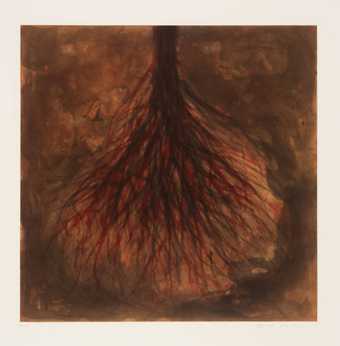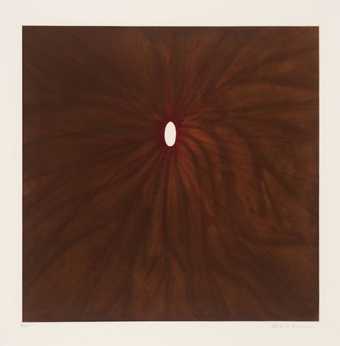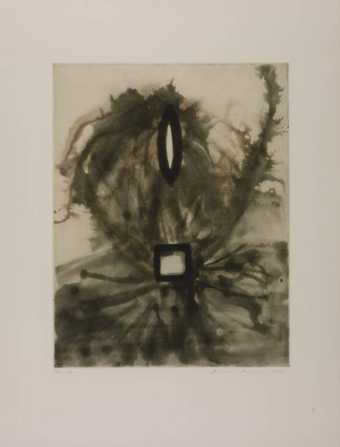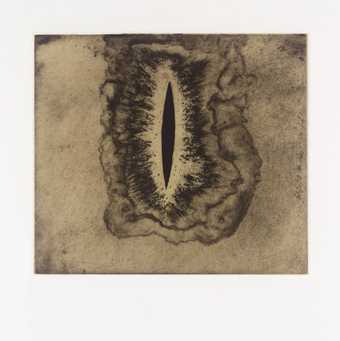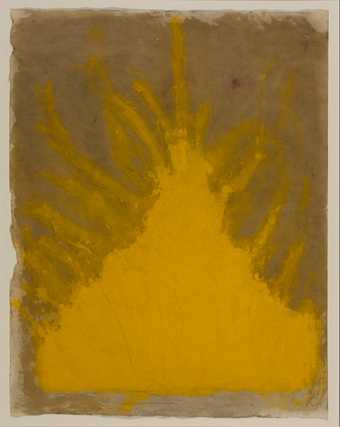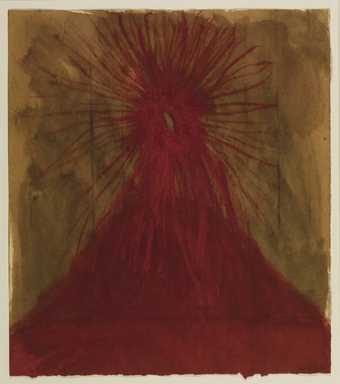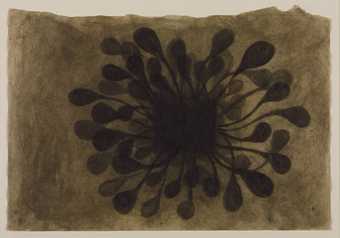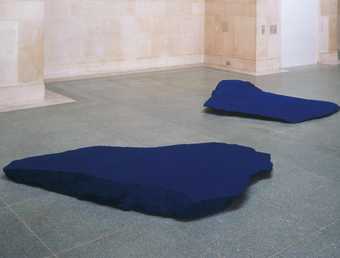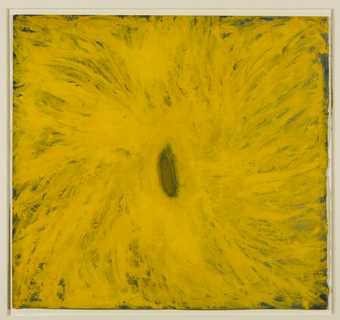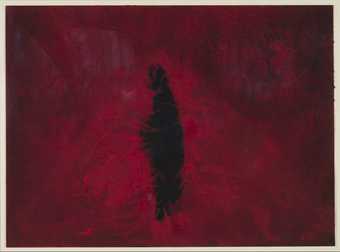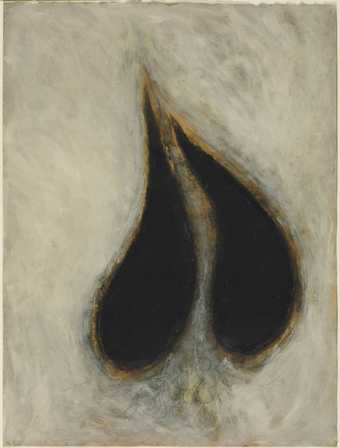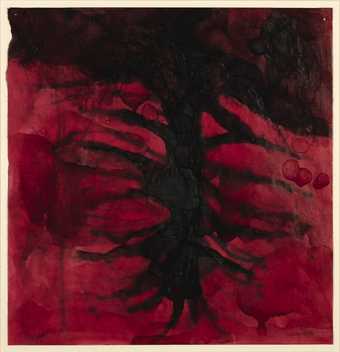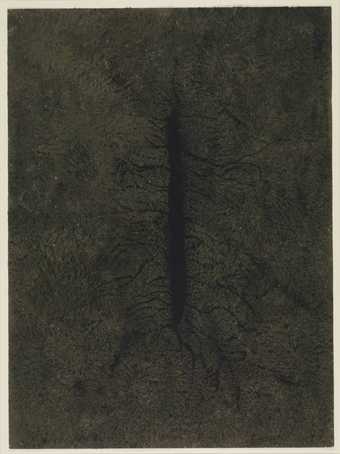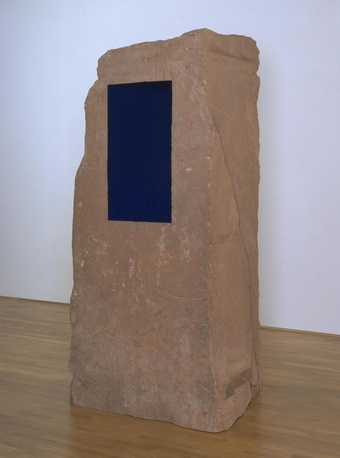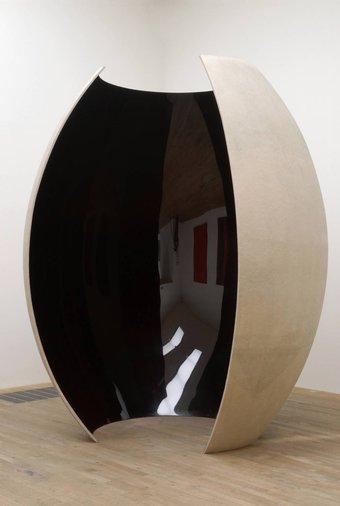
In Tate Liverpool
- Artist
- Sir Anish Kapoor CBE RA born 1954
- Medium
- Pigments, wood and plaster
- Dimensions
- Object: 970 × 762 × 1600 mm
object: 330 × 711 × 813 mm
object: 210 × 153 × 470 mm - Collection
- Tate
- Acquisition
- Purchased 1983
- Reference
- T03675
Catalogue entry
T03675 As if to celebrate, I discovered a mountain blooming with red flowers 1981
Wood, cement, polystyrene and pigment, 3 elements, 38 1/4 (at highest point) × 30 (at widest point, × 63 (970 × 762 × 1600); 13 × 28 × 32 (330 × 711 × 813); 8 1/4 × 6 × 18 1/2 (210 × 153 × 470), overall dimensions variable
Not inscribed
Purchased from the artist through Lisson Gallery (Grant-in-Aid) 1983
Exh: British Sculpture in the 20th Century. Part 2: Symbol and Imagination 1951–1980, Whitechapel Art Gallery, November 1981–January 1982 (158 in brochure); Anish Kapoor: As If to Celebrate, I Discovered a Mountain Blooming with Red Flowers, Walker Art Gallery, Liverpool, March–April 1982; Aperto, XL Biennale Venice, June–September 1982 (listed in general catalogue with incorrect illustration p.227); Anish Kapoor, Rotterdamse Kunststrichting, Galerie't Venster, Rotterdam, January–February 1983 (6, repr. p.6); New Art at the Tate Gallery 1983, September–October 1983 (not listed, repr. in col. p.47); An International Survey of Recent Painting and Sculpture, Museum of Modern Art, New York, May–August 1984 (repr. p.180); Forty Years of Modern Art 1945–1985, Tate Gallery, February–April 1986 (not listed, repr. in col. p.118)
Lit: Steve Baker, ‘Anish Kapoor at the Walker Art Gallery, Liverpool’, Artscribe, no.35, June 1982, p.67, repr.; Michael Newman, ‘Anish Kapoor’, Englische Plastik Heute/British Sculpture Now, exhibition catalogue, Kunstmuseum, Lucerne, July 1982 (n.p.); Marco Livingstone, catalogue introduction, Anish Kapoor, Feeling into Form, Le Sentiment de la forme, La Forme du Sentiment, exhibition catalogue, Walker Art Gallery, Liverpool, March 1983 (not listed, repr. in col. p.6); Mark Francis, ‘Anish Kapoor’, Transformations: New Sculpture from Britain, exhibition catalogue, XVII Bienal, São Paulo 1983, p.49, repr.; Lynne Cooke, ‘Mnemic Migrations’, Anish Kapoor, exhibition catalogue, Kunstnernes Hus, Oslo, 1986, repr. fig. VIII
Also repr: Paris Biennale, exhibition catalogue, Paris, October 1982, p.136; Artforum, xxi, November 1982, p.85 in col.; Tema Celeste, exhibition catalogue, Museo Civico d'Arte Contemporanea di Gibellina, Sicily, January 1983, p.54; Jean-Louis Pradel, World Art Trends 1982, New York 1983, p.117 in col.; introduction, The ‘Poetic’ Object, exhibition catalogue, The Douglas Hyde Gallery, Dublin 1985, p.7
Unless otherwise stated this entry is based on an interview with the artist (2 July 1986).
Kapoor made this work for the exhibition British Sculpture in the 20th Century, held at the Whitechapel Art Gallery in 1981–2. The invitation to exhibit at the Whitechapel came at a point when he was feeling the need to synthesise and to condense his previous larger installations into no less powerful but smaller and more specific groupings.
‘As if to celebrate ...’ and the works which directly preceded and followed it, ‘To reflect an intimate part of the red’ 1981, ‘Part of the red’ 1981, and ‘White Sand, Red Millet Many Flowers’ 1982, coll. Arts Council (documented by Michael Newman in the catalogue for Englische Plastik Heute, and reproduced in colour in Anish Kapoor, Feeling into Form, both catalogues cited above), all consist of small groups of between three and five objects. While based on the same repertoire of largely geometric and architectural forms Kapoor had been using in his earlier work, these and other works of around the same time herald the introduction of more obviously organic shapes into his sculpture (although they also appear to develop naturally from the hemispheres, stepped ziggurat shapes and mounds, of, for example the 1000 Names series (1979–80), his first works made with pure pigment.
In the catalogue cited, Michael Newman pointed out that, whereas previous works had been more site specific, these new groups, while still creating a ‘sense of place’, put more emphasis on the internal relationships between forms:
The objects were formed to be placed in the relationship with each other such that the charge of the whole would be greater than the sum of its parts...
With the third group [T03675], the geometrical architectural element has become a spectacular three-peaked mountain (the Hindu temple takes the form of a mountain and uses the metaphor of the body); the characteristic rounded form with an indentation like a cup has doubled and become like a pear or petal, making the connotation of breast more overt; and the third object, which is the smallest, is lifted off the ground on a curved surfacè and with its triangular, boat-like appearance suggests a directïonal movement. The three objects thus make a 3-2-1 sequence, and there is the suggestion that the ‘triple mountain’ is somehow related to the unity of ‘breasts’ and ‘boat’. In colour the latter is yellow while the other two objects are red. A wide range of movement is implied, ground-hugging, travelling, rising. As is often the case, the title provides a complement to the work, expressing its joy and exuberance.
The exact significance of T03675 remains private but according to Kapoor, the title comes from two main sources. The first part, ‘As if to celebrate ...’ is taken from a Haiku poem which he remembers reading on a train and deciding to use (he felt that the precision and economy of classical Haiku was appropriate to the spirit of the new work).
The second part of the title he invented but it relates to his having read the Hindu myth of the Goddess, who was born out of a fiery mountain which was composed of the bodies of male gods. Kapoor was interested in this image of the transmission and transmutation of power, the idea of the energy of one force giving way to or being translated into the energy and substance of another.
Although all his work of this period was beginning to hint at more organic presences, Kapoor feels that ‘As if to celebrate...’ and its companions are more specifically about physicality and in the case of T03675, birth, as denoted by the mythological reference in the title. However, despite his symbolic use of imagery (for example the two linked shapes suggesting breasts which are at the same time containers or pots, the proliferation of objects, from one single item to the tripartite red ‘mountain’) he is not interested in a narrow sexual interpretation.
Lynne Cooke (op.cit.) points to the importance of metonym in Kapoor's art and Kapoor stresses that work concerned only with formal arrangement or pleasing internal relationships, but without any suggestion of evolution and transformation, is not of interest to him. The objects or images must be worked to a point where they appear as symbols. However, formal considerations, for example the relationship between the elements, do contribute to what Kapoor likens to grammatical sense in a sentence - unless the works are grouped in the correct order, the sense is lost.
He also has a strong feeling for ritual, the bringing together of objects imbued with significance, as on an altar or shrine, where it is the combination of items in very precise relationships coupled with the particular site which is important for the believer.
In 1979, Kapoor returned to India for a visit after some years' absence. He feels that, in the past, too much has been made of this trip in relation to subsequent developments in his technique and imagery (which have been seen as having a specifically Indian quality or character). He sees the trip as having acted as a catalyst (as Lynne Cooke suggests, article cited above) and endorsing existing channels of investigation. On his return he made his first works out of coloured pigment. The use of powder, for which there is a precedent in Indian daily life and ritual, he also equates with the deliberate choice of ‘poor’ materials in the tradition of Arte Povera.
Kapoor describes ‘As if to celebrate ...’ as being about the coloured, not only in relation to the colour's more traditional symbolic attributes but also having a specific space/shape relationship. The small yellow wedge acts as a point of punctuation in relation to the whole. Kapoor makes drawings for his sculpture but in the case of T03675 these were all made direct on his studio wall while he was working on the shapes. The basic structure of this work is wood cement and polystyrene and when all the shapes (the three ‘cones’ of the mountain shape have now been mounted on one base) are in position, they are first painted with a weak pigment solution and afterwards covered with loose dry pigment which is flicked on to them with a brush so that no hand marks are made. (This perfection or absence of ‘hands’ also relates to religious rituals in various other cultures.) Ideally the audience should be able to circulate freely round the sculpture when it is in position.
This entry has been approved by the artist.
Published in:
The Tate Gallery 1982-84: Illustrated Catalogue of Acquisitions, London 1986
Explore
- abstraction(8,615)
-
- from recognisable sources(3,634)
- non-representational(6,161)
-
- colour(2,481)
- irregular forms(2,007)
- breast(103)
- sexual organs(178)
- birth to death(1,472)
-
- birth(77)
- psychology, Jung(29)
- gender(1,689)
You might like
-
Sir Anish Kapoor CBE RA Untitled
1989 -
Sir Anish Kapoor CBE RA Untitled
1989 -
Sir Anish Kapoor CBE RA Untitled 3
1988 -
Sir Anish Kapoor CBE RA [no title]
2000 -
Sir Anish Kapoor CBE RA Untitled
1987 -
Sir Anish Kapoor CBE RA Untitled
1987–8 -
Sir Anish Kapoor CBE RA Untitled
1986 -
Sir Anish Kapoor CBE RA A Wing at the Heart of Things
1990 -
Sir Anish Kapoor CBE RA Untitled
1989 -
Sir Anish Kapoor CBE RA Untitled
1990 -
Sir Anish Kapoor CBE RA Untitled
1986 -
Sir Anish Kapoor CBE RA Untitled
1989 -
Sir Anish Kapoor CBE RA Untitled
1989 -
Sir Anish Kapoor CBE RA Adam
1988–9 -
Sir Anish Kapoor CBE RA Ishi’s Light
2003

